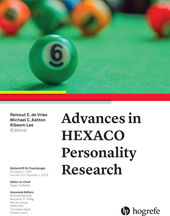Effects of HEXACO Traits and Experimental Provocation on Aggression
Abstract
Abstract. The aim of this study was to explore the effects of HEXACO traits and levels of provocation on aggressive behavior. The sample consisted of 168 participants randomly assigned to no-, low- or high-provocation conditions. Aggression was induced by the Taylor Aggression Paradigm, in which participants competed in a reaction time task wherein they received “punishments,” depending on the condition. The participants were also able to deliver the punishments, which represented the measure of aggression. Results showed that Honesty-Humility had substantively negative effects on aggression, regardless of the condition. Surprisingly, Agreeableness was unrelated to aggression. The results highlight the role of Honesty-Humility in aggression.
References
(1991). Multiple regression: Testing and interpreting interactions. Thousand Oaks, CA: Sage.
(2002). Human aggression. Annual Reviews of Psychology, 53, 27–55. https://doi.org/10.1146/annurev.psych.53.100901.135231
(2007). Empirical, theoretical, and practical advantages of the HEXACO model of personality structure. Personality and Social Psychology Review, 11, 150–166. https://doi.org/10.1177/1088868306294907
(2011). Exogenous cortisol facilitates responses to social threat under high provocation. Hormones and Behavior, 59, 428–434. https://doi.org/10.1016/j.yhbeh.2010.12.010
(2006). Personality and aggressive behavior under provoking and neutral conditions: A meta – analytic review. Psychological Bulletin, 132, 751–777. https://doi.org/10.1037/0033-2909.132.5.751
(2016). Unpacking more “evil”: What is at the core of the dark tetrad? Personality and Individual Differences, 90, 269–272. https://doi.org/10.1016/j.paid.2015.11.009
(2019). Ice and fire: Two paths to provoked aggression. Personality and Individual Differences, 138, 247–251. https://doi.org/10.1016/j.paid.2018.10.010
(2012). Adolescent bullying and personality: An adaptive approach. Personality and Individual Differences, 52, 218–223. https://doi.org/10.1016/j.paid.2011.10.028
(2011). Offender variables: Unique predictors of Benevolence, Avoidance, and Revenge? Personality and Individual Differences, 50, 1012–1017. https://doi.org/10.1016/j.paid.2010.12.037
(2018). Validating a standardized approach to the Taylor Aggression Paradigm Social. Psychological and Personality Science. Advance online publication. https://doi.org/10.1177/1948550618775408
(1988). Statistical power analysis for the behavioral sciences (2nd ed.). Hillsdale, NJ: Erlbaum.
(2014). Upitnik BODH (Bes, Osvetoljubivost, Dominacija, Hostilnost): Novi upitnik za procenu agresivnosti
[The AVDH questionnaire (Anger, Vengefulness, Dominance and Hostility): New questionnaire for the measurement of aggressiveness] . Primenjena Psihologija, 7, 297–324. https://doi.org/10.19090/pp.2014.3-1.297-324(2018). When you say aggressiveness, what do you mean by that? Similarities and differences between aggressiveness/agreeableness scales from personality inventories. Personality and Individual Differences, 134, 214–320. https://doi.org/10.1016/j.paid.2018.06.028
(2018). Effects of Dark Triad and HEXACO traits on reactive/proactive aggression: Exploring the gender differences. Personality and Individual Differences, 123, 44–49. https://doi.org/10.1016/j.paid.2017.11.003
(2016). The two faces of cooperation: On the unique role of HEXACO Agreeableness for forgiveness versus retaliation. Journal of Research in Personality, 64, 69–78. https://doi.org/10.1016/j.jrp.2016.08.004
(1976). Estimation of the Box correction for degrees of freedom from sample data in randomised block and split-plot designs. Journal of Educational Statistics, 1, 69–82.
(2018). The HEXACO model of personality and Dark Triad in relational aggression. Personality and Individual Differences, 122, 109–114. https://doi.org/10.1016/j.paid.2017.10.016
(2012). Getting mad and getting even: Agreeableness and Honesty-Humility as predictors of revenge intentions. Personality and Individual Differences, 52, 596–600. https://doi.org/10.1016/j.paid.2011.12.004
(2019). The HEXACO personality inventory: Validation and psychometric properties in the Serbian language. Journal of Personality Assessment, 101, 25–31. https://doi.org/10.1080/00223891.2017.1370426
(2014). Serbian adaptation of the Positive and Negative Affect Schedule (PANAS): Its facets and second-order structure. Psihologija, 47, 393–414. https://doi.org/10.2298/PSI1404393M
(2007). Human proactive aggression: Association with personality disorders and psychopathy. Aggressive Behavior, 33, 1–11. https://doi.org/10.1002/ab.20220
(2007). PsychoPy – Psychophysics software in Python. Journal of Neuroscience and Methods, 162, 8–13. https://doi.org/10.1016/j.jneumeth.2006.11.017
(2010). Personality and laboratory based aggression: Comparing the predictive power of the Five-Factor Model, BIS/BAS, and impulsivity across context. Journal of Research in Personality, 44, 13–21. https://doi.org/10.1016/j.jrp.2009.09.003
(2012). Predicting appraisals of romantic revenge: The roles of Honesty-Humility, Agreeableness, and Vengefulness. Personality and Individual Differences, 52, 128–132. https://doi.org/10.1016/j.paid.2011.09.014
(2018). Aggressiveness in the HEXACO personality model. Psihologija, 51, 449–468. https://doi.org/10.2298/PSI170705022S
(1967). Aggressive behavior and physiological arousal as a function of provocation and the tendency to inhibit aggression. Journal of Personality, 35, 297–310.



